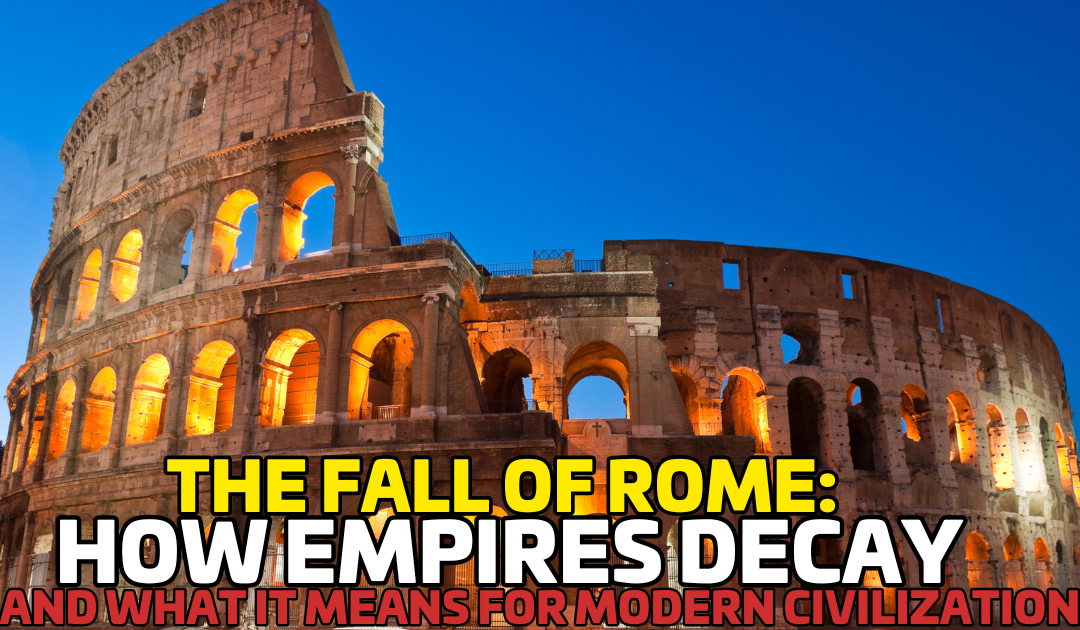Most empires don’t collapse overnight. They decay slowly, chipped away by weak leaders, economic strain, cultural shifts, and external threats. The story of the fall of Rome is not just ancient history, it is a warning to every modern civilization.
Today, as Western institutions struggle with instability, inflation, and fractured identities, looking back at Rome’s rise and decline offers vital lessons. In this article, we’ll explore how the fall of the Roman Empire went from unmatched glory to ruin.
From Augustus’ masterful rule to Odoacer’s deposition of Romulus Augustulus, the arc of Rome’s story teaches us what destroys empires and what we must do to prevent history from repeating.
The Transition from Republic to Empire: Augustus Sets the Stage
Rome’s Republic ended in 27 BC when Octavian, later known as Augustus, became the first emperor. He called himself “Princeps,” meaning first among equals, carefully preserving the illusion of shared governance while consolidating power.
Under Augustus, the Roman Empire at its peak stretched over 1.5 million square miles, ruling more than 130 million people. Yet, Augustus faced one fatal challenge: succession.
With no clear system in place, Rome’s future hinged on dynastic luck. His successors ranged from competent rulers like Tiberius to destructive ones like Caligula and Nero. The Julio-Claudian dynasty’s volatility showed how fragile centralized authority could be.
Nero’s paranoia, combined with his reckless spending, drained resources and shattered trust in leadership. After his death, Rome plunged into the Year of the Four Emperors (69 AD), ending with Vespasian.
Although the Flavian dynasty brought temporary stability, Domitian’s authoritarianism proved once again that strong rulers could steady Rome, but poor ones could accelerate its decline. The seeds of the fall of Rome were already being sown.
The Five Good Emperors: Rome’s Golden Age
After Domitian’s death in 96 AD, Rome entered an unprecedented era of prosperity under the Five Good Emperors: Nerva, Trajan, Hadrian, Antoninus Pius, and Marcus Aurelius. This period was marked by merit-based succession. Nerva adopted Trajan, a skilled general, as heir.
Trajan expanded Rome’s borders to their greatest extent, conquering Dacia and bringing immense wealth to the empire. Hadrian consolidated rather than expanded, building walls to secure Rome’s frontiers.
Antoninus Pius presided over stability, while Marcus Aurelius combined Stoic wisdom with wartime leadership. But even this golden age contained cracks. The Antonine Plague decimated the population, and Aurelius’ decision to name his biological son Commodus as heir ended the tradition of adopted merit.
Edward Gibbon later wrote that Rome shifted from a “kingdom of gold to one of iron and rust” after Aurelius’ death. The lesson is clear: leadership quality directly affects empire longevity. The fall of Rome accelerated whenever rulers placed family loyalty above competence.
Commodus and the Descent into Chaos
Commodus, ruling from 180 AD, embodied everything Rome feared in a leader. More interested in gladiatorial games than governance, he presented himself as Hercules reborn and even fought in the arena.
His paranoia led him to persecute senators and courtiers. In 192 AD, his reign ended when his concubine and a wrestler assassinated him. Declared an enemy of the state after death, Commodus’ rule revealed the empire’s fragility.
The chaos that followed, known as the Year of the Five Emperors (193 AD) paved the way for Septimius Severus. Though Severus strengthened the army and expanded military pay, he also increased fiscal pressure, leaving Rome dependent on soldiers’ loyalty.
His son Caracalla granted universal citizenship in 212 AD, not out of benevolence but to expand the tax base. This blurred Roman identity and diluted loyalty, weakening the cultural glue that once bound the empire together. The decline of Rome had shifted into overdrive.
The Crisis of the Third Century: Near Collapse
Between 235 and 284 AD, Rome endured what modern historians call the Crisis of the Third Century. Over 20 emperors rose and fell within 50 years, many assassinated by their own troops.
The empire fractured into three parts:
-
- The central Roman state
- The Gallic Empire in the West
- The Palmyrene Empire in the East
At the same time, barbarian invasions increased, with Goths and Alemanni attacking from the north. Economically, Rome was devastated. Currency debasement triggered hyperinflation up to 15,000%. Coins lost their value, trade collapsed, and black markets thrived.
Soldiers often demanded payment in kind instead of worthless money. This crisis nearly ended Rome centuries before its official fall. It exposed the fatal combination of poor leadership, external pressure, and internal disunity, the same dynamics that would later finish the empire. For a deeper dive, see our internal guide on currency debasement and inflation.
Aurelian: Restorer but Not Savior
Emperor Aurelian (270–275 AD) earned the title Restitutor Orbis– Restorer of the World. He reunited the fractured empire, crushed the Palmyrene Queen Zenobia, and defeated barbarian invaders. Yet even Aurelian could not escape the instability of his age. Assassinated by his own officers, his reign underscored how fragile power had become.
His construction of massive defensive walls around Rome symbolized the shift from expansion to survival. The fall of Rome was not inevitable yet, but its foundations were cracking.
Diocletian’s Reforms and the Seeds of the Middle Ages
When Diocletian came to power in 284 AD, Rome was in chaos. His solution was radical: divide power through the Tetrarchy, with two senior emperors (Augusti) and two junior emperors (Caesars). This administrative system improved efficiency but institutionalized division.
He also introduced dioceses as administrative units, which evolved into the basis of medieval European governance. Economically, his policies failed. He attempted price controls to curb inflation, but instead, they created black markets and further instability. His persecution of Christians alienated communities, undermining social cohesion.
When Diocletian abdicated in 305 AD, Rome was more autocratic, divided, and economically strained than ever. His reforms bought time, but they also transformed Rome into a precursor of medieval Europe.
The Final Collapse: From Sack to Fall
By the fourth century, barbarian influence had become overwhelming. Rome relied heavily on Gothic recruits to fill its armies, but these soldiers’ loyalties often shifted. In 410 AD, the Visigoths under Alaric sacked Rome, shocking the ancient world. Though the empire limped on, the symbolism was devastating. By 476 AD, the West was defenseless.
The boy-emperor Romulus Augustulus was deposed by the barbarian general Odoacer, who sent the imperial insignia to Constantinople. The fall of Rome in 476 AD ended Western imperial authority. While the Eastern Empire (Byzantium) survived until 1453, it was a Greek-speaking Christian state, far removed from classical Rome.
Modern Parallels: Lessons for Today
Why does the fall of Rome matter in 2025? Because its decline mirrors issues we face now:
-
- Weak Leadership: Commodus valued entertainment over governance. Today, leaders obsessed with optics over policy risk the same failure.
- Economic Instability: Caracalla’s desperate tax expansion echoes modern debt crises and inflationary policies.
- Cultural Identity: Rome’s diluted citizenship parallels today’s debates on immigration, national identity, and integration.
- Military Dependence: Just as Rome relied on mercenary troops, modern states risk outsourcing defense and security to unstable forces.
History does not repeat, but it rhymes. Rome’s story warns that civilizations crumble when they forget who they are and what sustains them. For deeper analysis, see our post on parallels to modern decay.
Why This Matters to You
Whether you’re a business leader, policymaker, or citizen, the lessons of the fall of Rome apply today. Civilizations thrive on strong leadership, economic health, cultural unity, and security. When these foundations weaken, collapse follows. By studying Rome’s decline, you can recognize the same warning signs in our world and work to reverse them.
Recognizing the Patterns
The fall of Rome in 476 AD marked the official end of the Western Roman Empire, but its collapse began centuries earlier- with Augustus’ unresolved succession system, Commodus’ self-indulgence, and the third-century crisis.
Inflation, fractured identity, and external pressure combined to erode what was once the world’s greatest power. Today, recognizing these patterns may be the difference between renewal and ruin. Rome teaches us that empires do not die suddenly, they rot from within. Stay vigilant, demand strong leadership, and protect the values that sustain civilization.
Follow me, Jeremy Ryan Slate, on X (@JeremyRyanSlate) for more insights on history’s lessons for our present. And if this article sparked thought, share it with others, because only by understanding the past can we secure the future.

